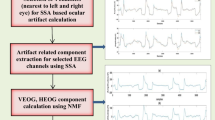Abstract
Electroencephalogram (EEG) is a record of the electrical activity of the brain and is a tool which gives an insight into the brain functions thereby helping the physicians to diagnose various abnormalities. Blinking or moving the eyes produces large electrical potential around the eyes known as Electrooculogram (EOG), which is a non-cortical activity that spreads across the scalp and contaminates the EEG and such contaminating potentials are called Ocular Artifacts (OA). EEG recordings are significantly distorted by OA, causing problems for analysis and interpretation by clinicians and a nuisance for researchers who investigate the electrophysiology of the brain. Hence, a control procedure for removal of OA from EEG is essential for interpreting EEG properly. In this paper, a hybrid ICA-Kalman Predictor algorithm is proposed to classify the independent components obtained from JADE (Joint Approximation Diagonalization of Eigen matrices) algorithm and remove OA automatically. The proposed design is implemented in matlab and the Mean Squared Error (MSE) of proposed Kalman method was 0.0017, significantly lower compared to results using ICA and ANC, which were 0.0468 and 0.0052 respectively.







Similar content being viewed by others
References
Bach, F. R., & Jordan, M. I. (2002). Kernel independent component analysis. Journal of Machine Learning Research, 3, 1–48.
Baraud, Y., Comte, F., Viennet, G., et al. (2001). Adaptive estimation in autoregression or-mixing regression via model selection. The Annals of Statistics, 29(3), 839–875.
Bell, A. J., & Sejnowski, T. J. (1995). An information-maximization approach to blind separation and blind deconvolution. Neural Computation, 7(6), 1129–1159.
Belouchrani, A., Abed-Meraim, K., Cardoso, J., & Moulines, E. (1993). Second-order blind separation of temporally correlated sources. In: Proceedings of the international conference on digital signal processing, (pp. 346–351). Citeseer.
Cardoso, J. F. (1999). High-order contrasts for independent component analysis. Neural Computation, 11(1), 157–192.
Choi, S., Cichocki, A., & Beloucharni, A. (2002). Second order nonstationary source separation. Journal of VLSI Signal Processing Systems for Signal, Image and Video Technology, 32(1–2), 93–104.
Comon, P. (1994). Independent component analysis, a new concept? Signal Processing, 36(3), 287–314.
Hyvärinen, A., & Oja, E. (1998). Independent component analysis by general nonlinear hebbian-like learning rules. Signal Processing, 64(3), 301–313.
Hyvärinen, A., & Oja, E. (2000). Independent component analysis: Algorithms and applications. Neural Networks, 13(4–5), 411–430.
Jung, T.P., Makeig, S., Lee, T.W., McKeown, M.J., Brown, G., Bell, A.J., Sejnowski, T.J., et al. (2000). Independent component analysis of biomedical signals. In: Proceedings of the international workshop on independent component analysis and signal separation, (pp. 633–644). Citeseer.
Jyothi, G. N., & Sridevi, S. (2018). Low power, low area adaptive finite impulse response filter based on memory less distributed arithmetic. Journal of Computational and Theoretical Nanoscience, 15(6–7), 2003–2008.
Lee, T. W., Girolami, M., & Sejnowski, T. J. (1999). Independent component analysis using an extended infomax algorithm for mixed subgaussian and supergaussian sources. Neural Computation, 11(2), 417–441.
Makeig, S., Bell, A. J., Jung, T. P., & Sejnowski, T. J. (1996). Independent component analysis of electroencephalographic data. Advances in Neural Information Processing Systems, 8, 145–151.
Mardia, K. V. (1970). Measures of multivariate skewness and kurtosis with applications. Biometrika, 57(3), 519–530.
Molgedey, L., & Schuster, H. G. (1994). Separation of a mixture of independent signals using time delayed correlations. Physical Review Letters, 72(23), 3634.
Praetorius, H., Bodenstein, G., & Creutzfeldt, O. (1977). Adaptive segmentation of eeg records: A new approach to automatic EEG analysis. Electroencephalography and Clinical Neurophysiology, 42(1), 84–94.
Rohál’ová, M., Sykacek, P., Koskaand, M., & Dorffner, G. (2001). Detection of the eeg artifacts by the means of the (extended) kalman filter. Measurement Science Review, 1(1), 59–62.
Schultz, C. A., Myers, S. C., Hipp, J., & Young, C. J. (1998). Nonstationary bayesian kriging: A predictive technique to generate spatial corrections for seismic detection, location, and identification. Bulletin of the Seismological Society of America, 88(5), 1275–1288.
Shoker, L., Sanei, S., & Chambers, J. (2005). Artifact removal from electroencephalograms using a hybrid bss-svm algorithm. IEEE Signal Processing Letters, 12(10), 721–724.
Stögbauer, H., Kraskov, A., Astakhov, S. A., & Grassberger, P. (2004). Least-dependent-component analysis based on mutual information. Physical Review E, 70(6), 066–123.
Supriya, P., & Nambiar, P. (2012). Integrated kalman-independent component analysis method for harmonic current estimation on an interconnected four bus simulated and laboratory model. International Journal of Emerging Electric Power Systems, 13(3), 1. https://doi.org/10.1515/1553-779X.2969.
Zhang, J., Welch, G., Bishop, G., & Huang, Z. (2013). A two-stage kalman filter approach for robust and real-time power system state estimation. IEEE Transactions on Sustainable Energy, 5(2), 629–636.
Ziehe, A., & Müller, K.R. (1998). Tdsep–An efficient algorithm for blind separation using time structure. In: International conference on artificial neural networks, (pp. 675–680). Springer.
Author information
Authors and Affiliations
Corresponding author
Additional information
Publisher's Note
Springer Nature remains neutral with regard to jurisdictional claims in published maps and institutional affiliations.
Rights and permissions
About this article
Cite this article
Devulapalli, S.P., Chanamallu, S.R. & Kodati, S.P. A hybrid ICA Kalman predictor algorithm for ocular artifacts removal. Int J Speech Technol 23, 727–735 (2020). https://doi.org/10.1007/s10772-020-09721-y
Received:
Accepted:
Published:
Issue Date:
DOI: https://doi.org/10.1007/s10772-020-09721-y




